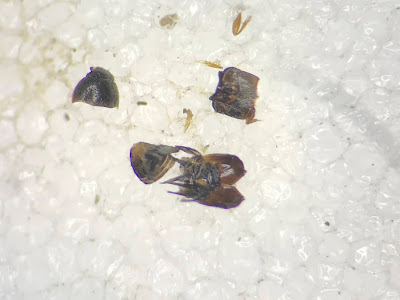After my rummaging through the big pile of reeds and straw a couple of weeks ago, I was still left with a few beetles to put a name to.
Many of these were the ptiliids, aka the dreaded featherwing beetles. There are a fair number of species and they don't get much above 1mm in length. There are keys but once you get to genus I find them pretty much useless. Partly because the differences are slight and partly because my microscope just can't cope with stuff that small at the resolution that is needed.
My preference is to dissect and hope for a female. Unlike, say staphs where the males naughty bits can elucidate an ID, for ptiliids it's the intricate spermatheca of the females that can be the clincher.
All the specimens I had were in the genus Acrotrichis, and look a bit like a mini trilobite with their tapered, pointed pronotal hind corners. My biggest issues is that in order to get the relevant bits out and get them under a microscope, I start with this...
...but end up finishing with this...
This means that I don't have any reference specimens for future comparison. Well I guess I could crudely try and reassemble the poor thing but it would be a fruitless task.
I put the spermatheca in a tiny drop of glycerol and then put them under the compound microscope for some proper scrutiny, usually moving through the different planes of focus and try and sketch a rough picture of the hoops, twists and whorls.
So what I do have is a bunch of images of the spermatheca as a reference for future comparison.
So here are the ones from the visit...
 |
| Acrotrichis henrici |
 |
| Acrotrichis montandonii |
 |
| Acrotrichis fascicularis |
The images don't really do these amazing structures justice. As Max Baclay said on twitter 'any sperm that can negotiate this deserves to fertilise the egg!'. And he's not wrong.


nicely done
ReplyDeleteThanks for this....having completely mullered several recently (probably not the ideal first family to try a gen det on!!) this has encouraged me to keep trying!
ReplyDelete